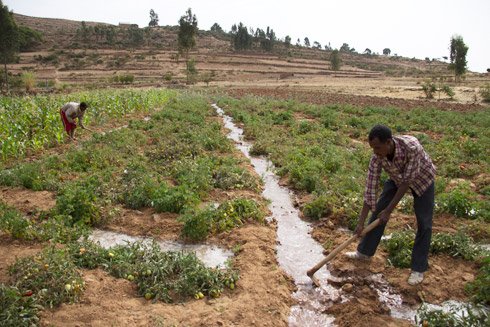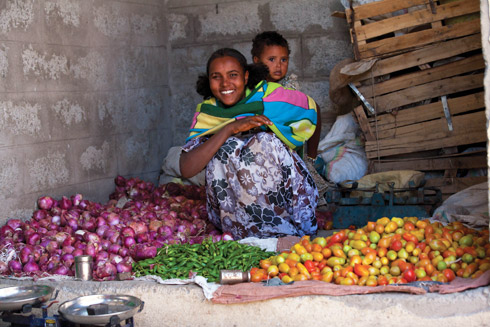Background
Political
Ethiopia is almost unique in Africa because, apart from a five-year occupation by Italy during the Mussolini years, it has never been colonised. Under Emperor Haile Selassie, Ethiopia was a feudal empire until 1974, when a military junta took power.
Two decades have passed since the Ethiopian People’s Revolutionary Democratic Front (EPRDF) took power and embarked on transforming Ethiopia into a more developed, democratic and egalitarian society. This task remains a work in progress.
The Ethiopian Government strongly emphasises economic growth, while retaining a very strong commitment and focus on human development and poverty reduction. It aims to to transform Ethiopia into a middle income country by 2025, eradicating poverty while promoting equality and equity.
Ethiopia plays an important role in regional politics, mediating, for instance, between the parties in South Sudan. It also plays an active role in Somalia both in terms of political dialogue and military support of the African Union Mission in Somalia (AMISOM). Relations with Eritrea remain tense.
Economic
Ethiopia is now sub-Saharan Africa’s fifth biggest economy. Macro-economic performance has remained strong over the last decade recording annual GDP growth rates of over 7% per year since 2008. Continued rapid economic expansion is possible but it will need careful management. Oil, if discovered, would be a significant development.
Industry accounts for only 9% of the national Gross Domestic Product (GDP), which is significantly lower than other sub-Saharan African countries, where the average is 32%. There have been some positive developments in attracting flower and horticulture businesses but this employment is low waged, low skilled and may have hidden environmental costs.
In recent years, there have also been increased agricultural exports (coffee, oil seeds, horticulture and khat). Overall, agricultural production has increased but sustained growth in agricultural output is not assured. Ethiopia is still dependent on commercial food imports and food assistance.
Productivity is also constrained by land quality, the size of individual holdings and limited availability of inputs such as seed and fertiliser. Some 85% of Ethiopia’s population live in rural areas and the millions who depend on smallholder farming for their livelihoods are vulnerable to erratic seasonal rainfall, soil erosion, insecurity of tenure and high population growth. The northern region of Tigray is especially vulnerable to land degradation. Inefficiency of domestic markets and inadequate transport infrastructure also hinders distribution.

Development
Ethiopia is ranked 173 out of 187 on the United Nations’ Human Development Index (Ireland is currently ranked eleventh). Huge progress has been made in recent years in economic growth and human development, and while the food security situation remains fragile in places and the population continues to increase, there has been no repeat of the famine of 1984-5, when up to one million people lost their lives. Life expectancy in Ethiopia has increased from 56 to 59.7 over the past few years, and, of a total population of more than 94 million, some 25 million people live below the national poverty line. However, the proportion of people living on less than $1.25 a day has decreased from 46% in 2000 to 27.6% in 2011/2012.
While poverty rates are improving overall, the severity of poverty being experienced in some rural areas is intensifying, relative to urban areas. And while the rate of population growth is slowing, it remains high at over 2% or two million additional people per year. Ethiopia is expected to have a population of close to 120 million in 2025, the year it aims to attain middle income status. The health sector has recorded some impressive developments in recent years, with mortality rates for children under five decreasing from 123 per 1,000 live briths in 2005 to to 68 In 2013 (achieving MDG 5). However, the lack of progress on maternal mortality is a critical concern for the Government and for development partners. Rates remain amongst the worst in the world (673/100,000 in 2005 and 676/100,000 in 2011). Just 34% of Ethiopian women receive some antenatal care from a skilled provider, although this is up from 28% in 2005.
The Ethiopian Government recognises that there is a need to addresses gender-related health issues as these undermine efforts elsewhere to improve child health and nutrition, productivity and economic growth in general.
Ethiopia still faces challenges such as recurring food insecurity. A very significant number of the population remains food insecure. Between 10 and 12 million Ethiopians are likely to need support to meet their basic food requirements in any given year and 44% of the population consume less than their daily calorie requirements. Currently, 44% of children under the age of five are stunted, 27% of Ethiopian women are too thin and 17% are anaemic.
For crisis-prone communities, erratic rains, continuing food price inflation (at 47.5% in February 2012), high fuel prices and related volatile inflation are amongst some of the factors that contribute to extreme vulnerability.
And Ethiopia is particularly vulnerable to climate change, especially variations in rainfall patterns. It is also vulnerable to drought and other natural disasters such as floods, heavy rains, frost and heat waves.
The humanitarian response system in Ethiopia is relatively robust and, in 2011, was attributed with averting major loss of life. However, there are concerns around whether the humanitarian response system can sustain its performance into the future as it is coping with increasing frequency, cost, variety and geographic spread of humanitarian needs within its borders.



